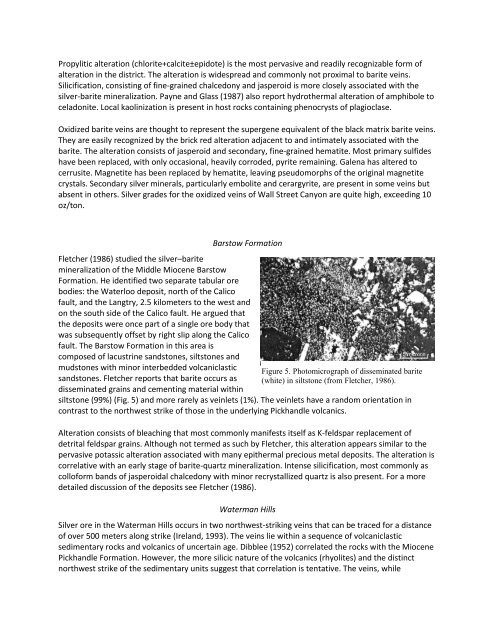Geology and Ore Genesis of Silver–Barite Mineralization in the ...
Geology and Ore Genesis of Silver–Barite Mineralization in the ...
Geology and Ore Genesis of Silver–Barite Mineralization in the ...
Create successful ePaper yourself
Turn your PDF publications into a flip-book with our unique Google optimized e-Paper software.
Propylitic alteration (chlorite+calcite±epidote) is <strong>the</strong> most pervasive <strong>and</strong> readily recognizable form <strong>of</strong><br />
alteration <strong>in</strong> <strong>the</strong> district. The alteration is widespread <strong>and</strong> commonly not proximal to barite ve<strong>in</strong>s.<br />
Silicification, consist<strong>in</strong>g <strong>of</strong> f<strong>in</strong>e-gra<strong>in</strong>ed chalcedony <strong>and</strong> jasperoid is more closely associated with <strong>the</strong><br />
silver-barite m<strong>in</strong>eralization. Payne <strong>and</strong> Glass (1987) also report hydro<strong>the</strong>rmal alteration <strong>of</strong> amphibole to<br />
celadonite. Local kaol<strong>in</strong>ization is present <strong>in</strong> host rocks conta<strong>in</strong><strong>in</strong>g phenocrysts <strong>of</strong> plagioclase.<br />
Oxidized barite ve<strong>in</strong>s are thought to represent <strong>the</strong> supergene equivalent <strong>of</strong> <strong>the</strong> black matrix barite ve<strong>in</strong>s.<br />
They are easily recognized by <strong>the</strong> brick red alteration adjacent to <strong>and</strong> <strong>in</strong>timately associated with <strong>the</strong><br />
barite. The alteration consists <strong>of</strong> jasperoid <strong>and</strong> secondary, f<strong>in</strong>e-gra<strong>in</strong>ed hematite. Most primary sulfides<br />
have been replaced, with only occasional, heavily corroded, pyrite rema<strong>in</strong><strong>in</strong>g. Galena has altered to<br />
cerrusite. Magnetite has been replaced by hematite, leav<strong>in</strong>g pseudomorphs <strong>of</strong> <strong>the</strong> orig<strong>in</strong>al magnetite<br />
crystals. Secondary silver m<strong>in</strong>erals, particularly embolite <strong>and</strong> cerargyrite, are present <strong>in</strong> some ve<strong>in</strong>s but<br />
absent <strong>in</strong> o<strong>the</strong>rs. Silver grades for <strong>the</strong> oxidized ve<strong>in</strong>s <strong>of</strong> Wall Street Canyon are quite high, exceed<strong>in</strong>g 10<br />
oz/ton.<br />
Barstow Formation<br />
Fletcher (1986) studied <strong>the</strong> silver–barite<br />
m<strong>in</strong>eralization <strong>of</strong> <strong>the</strong> Middle Miocene Barstow<br />
Formation. He identified two separate tabular ore<br />
bodies: <strong>the</strong> Waterloo deposit, north <strong>of</strong> <strong>the</strong> Calico<br />
fault, <strong>and</strong> <strong>the</strong> Langtry, 2.5 kilometers to <strong>the</strong> west <strong>and</strong><br />
on <strong>the</strong> south side <strong>of</strong> <strong>the</strong> Calico fault. He argued that<br />
<strong>the</strong> deposits were once part <strong>of</strong> a s<strong>in</strong>gle ore body that<br />
was subsequently <strong>of</strong>fset by right slip along <strong>the</strong> Calico<br />
fault. The Barstow Formation <strong>in</strong> this area is<br />
composed <strong>of</strong> lacustr<strong>in</strong>e s<strong>and</strong>stones, siltstones <strong>and</strong><br />
mudstones with m<strong>in</strong>or <strong>in</strong>terbedded volcaniclastic<br />
s<strong>and</strong>stones. Fletcher reports that barite occurs as<br />
dissem<strong>in</strong>ated gra<strong>in</strong>s <strong>and</strong> cement<strong>in</strong>g material with<strong>in</strong><br />
siltstone (99%) (Fig. 5) <strong>and</strong> more rarely as ve<strong>in</strong>lets (1%). The ve<strong>in</strong>lets have a r<strong>and</strong>om orientation <strong>in</strong><br />
contrast to <strong>the</strong> northwest strike <strong>of</strong> those <strong>in</strong> <strong>the</strong> underly<strong>in</strong>g Pickh<strong>and</strong>le volcanics.<br />
Alteration consists <strong>of</strong> bleach<strong>in</strong>g that most commonly manifests itself as K-feldspar replacement <strong>of</strong><br />
detrital feldspar gra<strong>in</strong>s. Although not termed as such by Fletcher, this alteration appears similar to <strong>the</strong><br />
pervasive potassic alteration associated with many epi<strong>the</strong>rmal precious metal deposits. The alteration is<br />
correlative with an early stage <strong>of</strong> barite-quartz m<strong>in</strong>eralization. Intense silicification, most commonly as<br />
coll<strong>of</strong>orm b<strong>and</strong>s <strong>of</strong> jasperoidal chalcedony with m<strong>in</strong>or recrystallized quartz is also present. For a more<br />
detailed discussion <strong>of</strong> <strong>the</strong> deposits see Fletcher (1986).<br />
Waterman Hills<br />
Figure 5. Photomicrograph <strong>of</strong> dissem<strong>in</strong>ated barite<br />
(white) <strong>in</strong> siltstone (from Fletcher, 1986).<br />
Silver ore <strong>in</strong> <strong>the</strong> Waterman Hills occurs <strong>in</strong> two northwest-strik<strong>in</strong>g ve<strong>in</strong>s that can be traced for a distance<br />
<strong>of</strong> over 500 meters along strike (Irel<strong>and</strong>, 1993). The ve<strong>in</strong>s lie with<strong>in</strong> a sequence <strong>of</strong> volcaniclastic<br />
sedimentary rocks <strong>and</strong> volcanics <strong>of</strong> uncerta<strong>in</strong> age. Dibblee (1952) correlated <strong>the</strong> rocks with <strong>the</strong> Miocene<br />
Pickh<strong>and</strong>le Formation. However, <strong>the</strong> more silicic nature <strong>of</strong> <strong>the</strong> volcanics (rhyolites) <strong>and</strong> <strong>the</strong> dist<strong>in</strong>ct<br />
northwest strike <strong>of</strong> <strong>the</strong> sedimentary units suggest that correlation is tentative. The ve<strong>in</strong>s, while

















